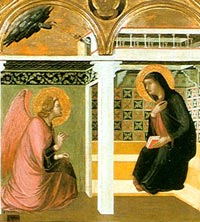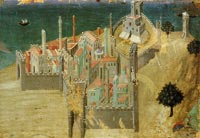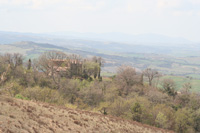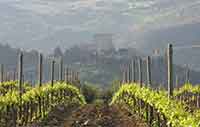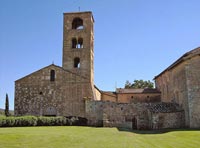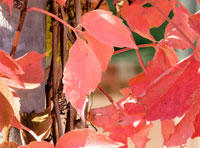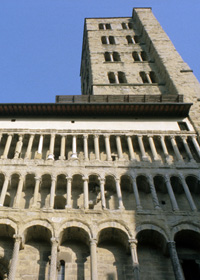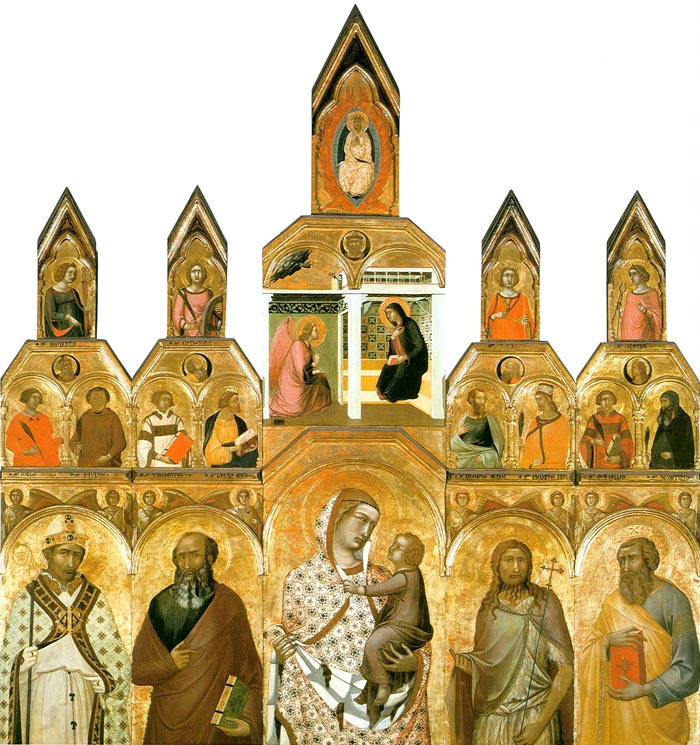 |
|
Pietro Lorenzetti, The Tarlati polyptych (Polittico di Santa Maria della Pieve ad Arezzo), 1320, tempera on wood, Pieve di Santa Maria, Arezzo
|
|
|
| The Tarlati polyptych or Polittico di Santa Maria della Pieve ad Arezzo, is a Renaissance polyptych painted by the Italian artist Pietro Lorenzetti, with tempera and gold on panel, in 1320. It is located at the Church of Santa Maria della Pieve in Arezzo, Italy. It depicts the Madonna and Child with Donatus of Arezzo, John the Evangelist, John the Baptist and Saint Matthew. The term Tarlati refers to Guido Tarlati, who was the bishop of Arezzo and died in 1327. |
|
||||
[1] The term Tarlati refers to Guido Tarlati, who was the bishop of Arezzo and died in 1327. Tarlati became bishop of 1312 and during his administration the city had good relations with its neighbor Florence. According to Giorgio Vasari the tomb commissioned by Guido's brother, the condottiero Pier Saccone Tarlati di Pietramala, was designed by Giotto, who recommended to Pier Saccone the Sienese sculptors Agnolo and Agostino to execute it.
|
||||
Giorgio Vasari | Lives of the Artists | Ambrogio Lorenzetti |
||||
| Ambrogio Lorenzetti's City by the Sea is one of the treasures of Sienese art. It's also a questionable picture. What kind of scene is it? Some people see it as a fragment cut from a larger image. Some see it as an independent landscape. Either way, it is not isolated. City by the Sea has a companion image, Castle on a Lake, of the same size and shape, and with a view that seems approximately continuous. Both paintings are now attributed to Sassetta, as being part of the Arte della Lana Altarpiece. The triptych, the first known work by Sassetta, was commissioned by the "Arte della Lana", i.e. the woolmerchants' guild for the church of the Carmelite Order in Siena in 1423. Art in Tuscany | Sassetta |
||||
|
||||
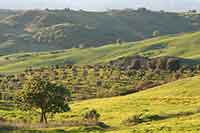 |
||||
Podere Santa Pia |
Pienza and the Val d'Orcia |
Century-old olive trees, between Podere Santa Pia and Cinigiano |
||
Monte Cucco wine region |
Cipresses between Montalcino and Pienza |
Sovicille |
||
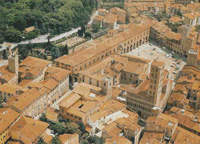 |
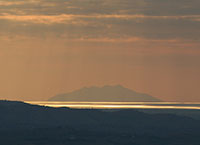 |
|||
Wines in southern Tuscany |
Arezzo |
Sunsets in Tuscany |
||
 |
||||
Podere Santa Pia, a spacious, comfortable and well furnished holiday home, offers its guests a breathtaking views over the Maremma hills, up to the Tyrrhenian coast and Monte Christo |
||||
| Pieve di Santa Maria, Arezzo |
||||
| Pieve di Santa Maria, completely built of sandstone and situated between Corso Italia and the Piazza Grande behind, is one of the largest and most attractive Romanesque parish churches (or peeve in Italian) in Tuscany. The church has a magnificent Romanesque arcaded facade adorned with dozens of carved columns, each uniquely decorated. The campanile, dating from 1330 is therefore called the campanile dale cento buche (hundred holed bellower). The Romanesque facade was originally simple, but, with the rise of Pisan influence, a series of blind arches surmounted by three sets of horizontally crowned porticos were added to the lower floor. There is a wealth of sculptures of various origins: worthy of note are the 13th century composition dedicated to the Madonna in the lunette of the main portal and the basrelief above the central doorway. These carved reliefs known as the Cyclo dei Mesi represent the months of the year. January's figure has two faces: one looks back on the previous year and the other looks forward. Inside, the undoubted highlight is Pietro Lorenzetti's famous polyptych, Madonna and Saints (1320–24), painted by Pietro Lorenzetti for bishop Guido Tarlati. Below the altar is a 14th-century silver bust reliquary of the city's patron saint, San Donato. Other treasures include a 13th-century crucifix by Margarito di Arezzo, which hangs near the door to the sacristy, and a fresco on a column behind the alter (left-hand side) of Saints Francesco and Domenico by the early 14th century artist of Giotto's school Andrea di Nerio (1331–69). Address Street Corso Italia 7 Churches in Tuscany | Arezzo | Santa Maria della Pieve |
Pieve di Santa Maria, Arezzo |
|||

